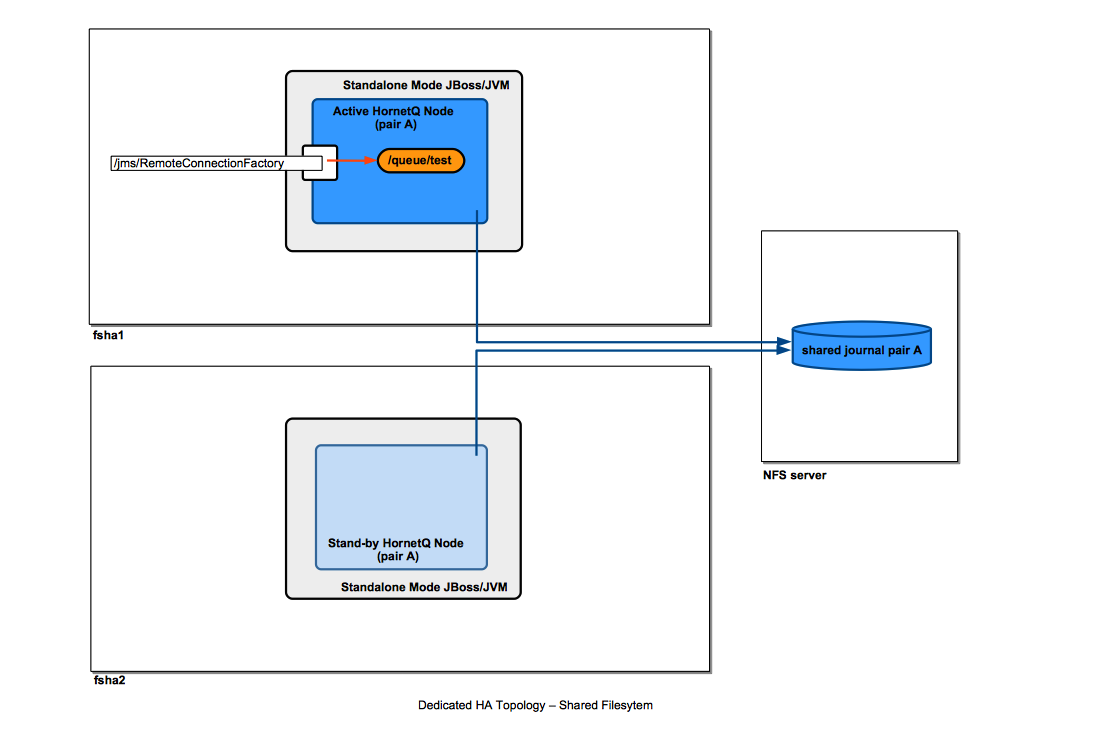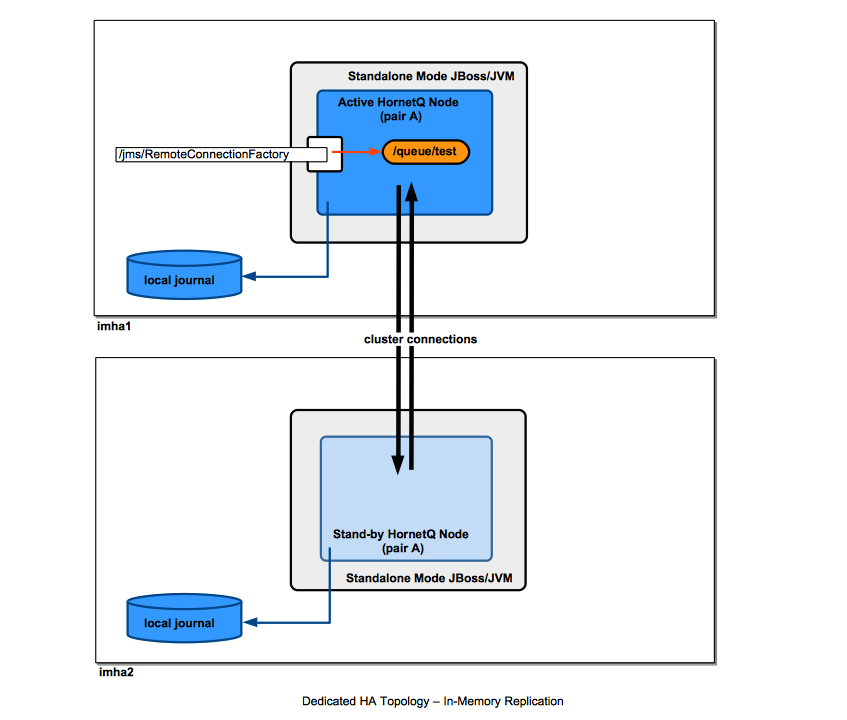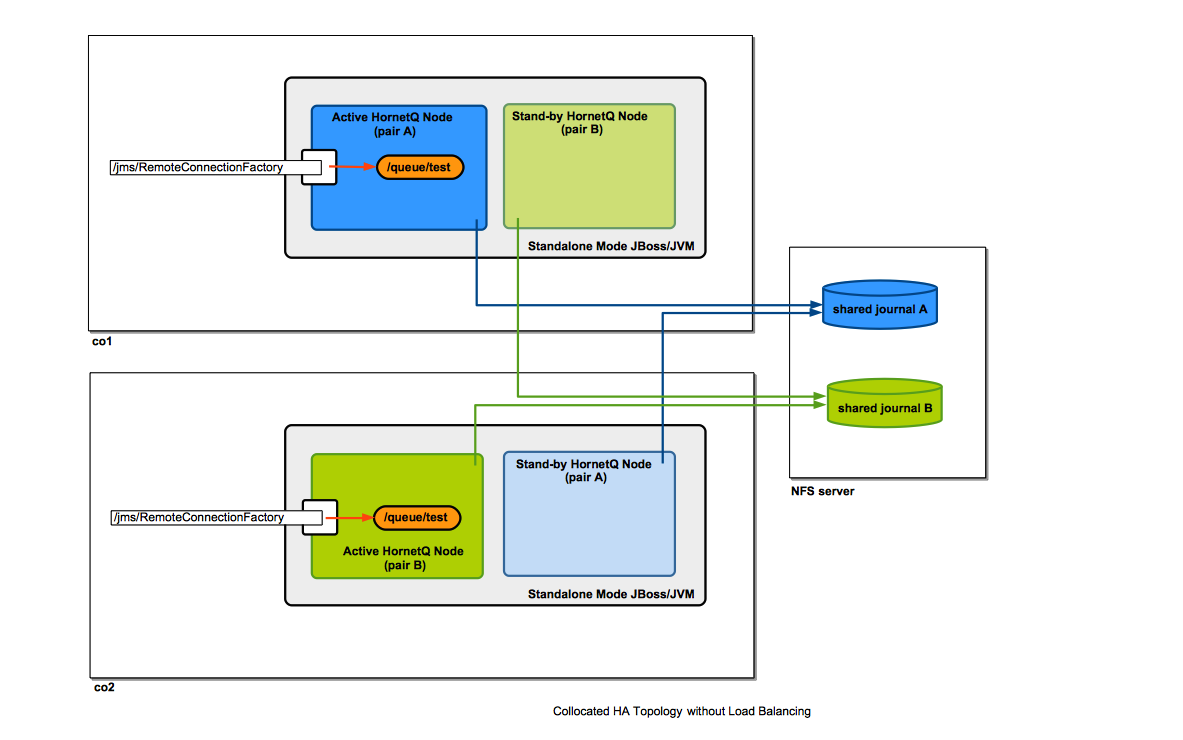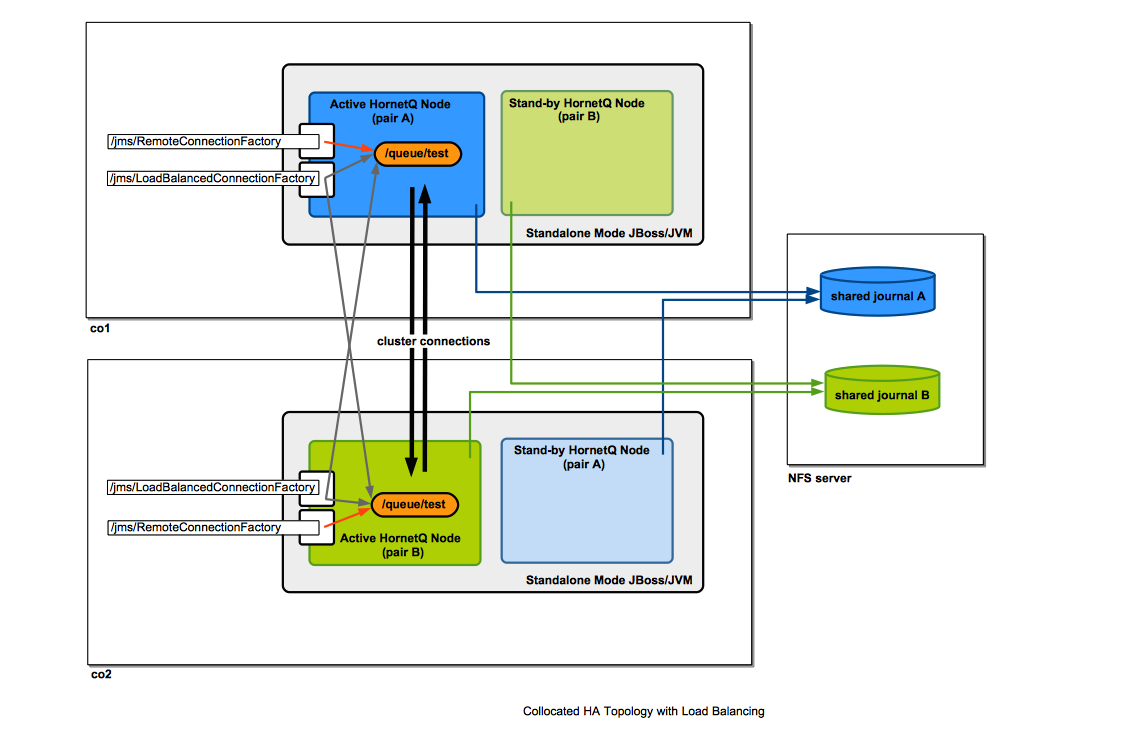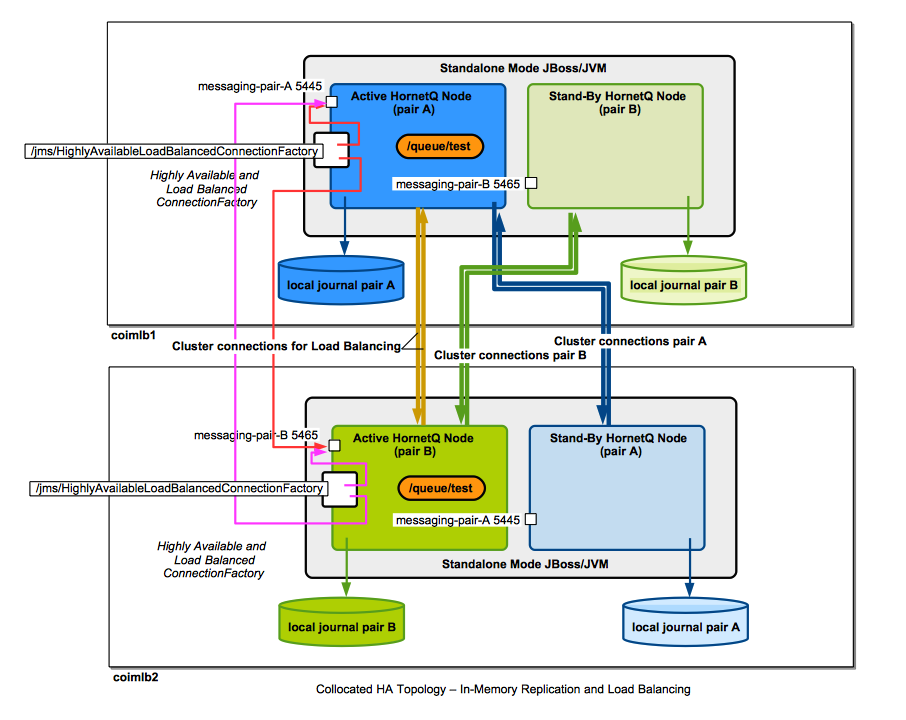WildFly HornetQ-Based Messaging Subsystem Concepts
External
- Messaging chapter in "EAP 6.4 Administration and Configuration Guide" https://access.redhat.com/documentation/en-US/JBoss_Enterprise_Application_Platform/6.4/html/Administration_and_Configuration_Guide/chap-Messaging.html
- HornetQ User Manual http://docs.jboss.org/hornetq/2.4.0.Final/docs/user-manual/html/index.html
Internal
Overview
This page contains a descriptions of the concepts behind WildFly HornetQ-based messaging subsystem.
Address
Acceptors and Connectors
Acceptor
An acceptor is a HornetQ mechanism that defines which types of connections are accepted by a HornetQ server. A specific acceptor matches a specific connector that initiates the connection. The connectors can be thought of as "the initiating end of the connection" and they are either clients or other server nodes that attempt to cluster.
Connector
A connector is a HornetQ mechanism that defines how a client or another server can connect to a server. The connector information is used by the HornetQ clients. A specific connector matches a specific acceptor. A server may broadcast its connectors over network, as a way to make itself known and allow clients (and other servers in the same cluster) to connect to it.
Address
Persistence
Paging
Security
HornetQ does not allow creation of unauthenticated connections. The connection's user name and password are authenticated against the "other" security domain, and the user must belong to the "guest" role. The security domain name is not explicitly specified in the configuration, but the default value is "other", and the following declaration has the same effect as the default configuration:
<subsystem xmlns="urn:jboss:domain:messaging:1.2">
<hornetq-server>
...
<security-domain>other</security-domain>
...
For more details about the relationship between security domains and security realms, see Relationship between a Security Realm and a Security Domain.
Users can be added to the ApplicationRealm with add-user.sh. The user can be added to a certain role by assigning it to a "group" with the same name when adding with add-user.sh.
For details on how to secure destinations, see:
For details on how to secure cluster connections, see:
Connection Factory
Sending Messages
send()
By default, non-transactional persistent messages are sent in blocking mode: the sending thread blocks until the acknowledgement for the message is received from the server. The configuration elements that controls this behavior, for both durable and non-durable messages, are block-on-durable-send and block-on-non-durable-send. The actual values a server is configured with can be obtained via CLI:
/subsystem=messaging/hornetq-server=active-node-pair-A/connection-factory=HighlyAvailableLoadBalancedConnectionFactory:read-attribute(name=block-on-durable-send)
Relationship between block-on-durable-send and block-on-acknowledge, it is probably related to "asynchronous send acknowledgements". More documentation: http://docs.jboss.org/hornetq/2.4.0.Final/docs/user-manual/html_single/#non-transactional-sends. http://docs.jboss.org/hornetq/2.4.0.Final/docs/user-manual/html_single/#send-guarantees.nontrans.acks, http://docs.jboss.org/hornetq/2.4.0.Final/docs/user-manual/html_single/#asynchronous-send-acknowledgements.
HornetQ allows for an optimization called "Asynchronous Send Acknowledgements": the acknowledgment is sent back on a separate stream. The send() method still blocks until it receives the acknowledgment.
Writing to Journal
Once a persistent message reaches the server, it must be written to the journal. Writing to journal is controlled by the journal-sync-transactional and journal-sync-non-transactional. Both are true by default.
The actual value can be read with CLI:
/subsystem=messaging/hornetq-server=active-node-pair-A:read-attribute(name=journal-sync-non-transactional)
Also see:
Clustering
- EAP 6.4 Administation and Configuration Manual - HornetQ Clustering https://access.redhat.com/documentation/en-US/JBoss_Enterprise_Application_Platform/6.4/html/Administration_and_Configuration_Guide/sect-HornetQ_Clustering.html
Clustering in this context means establishing a mesh of HornetQ brokers. The main purpose of creating a cluster is to spread message processing load across more than one node. Each active node in the cluster acts as an independent HornetQ server and manages its own connections and messages. HornetQ insures that messages can be intelligently load balanced between the servers in the cluster, according to the number of consumers on each node, and whether they are ready for messages. HornetQ also has the ability to automatically redistribute messages between nodes of a cluster to prevent starvation on any particular node.
Clustering does not automatically insure high availability. Go here for more details on HornetQ high availability.
Cluster Connection
The elements that turns a HornetQ instance into a clustered HornetQ instance is the presence of one or more cluster connections in the configuration, and the configuration setting that tells the instance that is clustered: <clustered>true</clustered>.
The cluster connections represents bidirectional? unidirectional? connections between nodes. They need to be explicitly declared in configuration. Messages are passed between nodes over core bridges. Core bridges consume messages from a source queue and forward them to a target queue deployed on a HornetQ node which may or may not be in the same cluster. When a node forms a cluster connection with another node, it automatically creates a core bridge internally. For more details on how to configure a WildFly HornetQ-based messaging cluster see:
Broadcast and Discovery Groups
Broadcast Group
A broadcast group is a HornetQ mechanism used to advertise connector information over the network. If the HornetQ server is configured for high availability, thus has an active and a stand-by node, the broadcast group advertises connector pairs: a live server connector and a stand-by server connector.
Broadcast groups use internally either UDP multicast or JGroups channels.
Discovery Group
A discovery group defines how connector information broadcasted over a broadcast group is received from the broadcast endpoint. Discovery groups are used by JMS clients and cluster connections to obtain the initial connection information in order to download the actual topology.
A discovery group maintains lists of connectors (or connector pairs, in case the server is HA), one connector per server. Each broadcast updates the connector information.
A discovery group implies a broadcast group, so they require either UDP or JGroups.
Does "discovery group" intrinsically mean multicast - or we can have "static" discovery groups where the connectors are statically declared?
Client-Side Load Balancing
All a client needs to do in order to load balance messages across a number of HornetQ nodes is to look up a connection factory that was configured to load balance amongst those nodes. The functionality has been tested with EAP 6.4. For an example of how such a connection factory is configured see: Configure a ConnectionFactory for Load Balancing.
High Availability
- EAP 6.4 Administration and Configuration Guide - HornetQ High Availability https://access.redhat.com/documentation/en-US/JBoss_Enterprise_Application_Platform/6.4/html/Administration_and_Configuration_Guide/sect-High_Availability.html
- Configure high-availability and fail-over for HornetQ in JBoss EAP 6 https://access.redhat.com/solutions/169683
High Availability in this context means the ability of HornetQ to continue functioning after the failure of one or more nodes. High availability is implemented on the server side by using a pair of active/stand-by (backup) broker nodes, and on the client side by logic that allows client connections to automatically migrate from the active sever to the stand-by server in event of active server failure.
High Availability does not necessarily mean that the load is spread across more than one active node. Go here for more details about HornetQ clustering for load balancing.
Replication Types
For step-by-step instruction on how to configure such a topology see:
For an example of a shared filesystem-based replication diagram, see Collocated Topology below.
In-Memory Replication
In a in-memory replication configuration, the active and stand-by nodes do not share filesystem-based data stores. The message replication is done via network traffic over cluster connections. A backup server will only replicate with a live server within the same group name (<backup-group-name>). Note that a backup group name only has two nodes: the active and the stand-by.
For in-memory replication, the journals, and not individual messages are replicated. Since only the persistent messages make it to the journal, only the persistent messages are replicated.
When the backup server comes on-line, it attempts to connect to its live server to attempt synchronization. While the synchronization is going on, the node is unavailable as backup server. If the backup server comes online and no live server is available, the backup server will wait until the live server is available in the cluster.
if the live server fails, the fully synchronized backup server attempts to become active. The backup server will activate only if the live server has failed and the backup server is able to connect to more than half of the servers in the cluster. If more than half of the other servers in the cluster also fail to respond it would indicate a general network failure and the backup server will wait to retry the connection to the live server.
Fail-back: To get to the original state after failover, it is necessary to start the live server and wait until it is fully synchronized with the backup server. When this has been achieved, the original live server will become active only after the backup server is shut down. This happens automatically if the <allow-failback> attribute is set to true.
How is the Replication Done
Configuration
For step-by-step instruction on how to configure such a topology see:
Dedicated Topology
For step-by-step instruction on how to configure such a topology see:
Collocated Topology
The diagram shows an example of collocated topology where the high availability is insured by writing journals on a shared file system.
For step-by-step instruction on how to configure such a topology see:
Collocated Topology with In-Memory Replication, no Load Balancing
The diagram shows an example of collocated topology where the high availability is achieved by in-memory replication. No shared filesystem is required.
For step-by-step instruction on how to configure such a topology see:
Collocated Topology with Load Balancing
Collocated Topology with In-Memory Replication and Load Balancing
Server State Replication
TODO Explain this:
HornetQ does not replicate full server state between live and backup servers. When the new session is automatically recreated on the backup it will not have any knowledge of messages already sent or acknowledged in that session. Any in-flight sends or acknowledgments at the time of fail-over might also be lost.
Client-Side Failover
Playground Example
TODO
Failover Limitations
Due to the way HornetQ was designed, the failover is not fully transparent and it requires application’s cooperation.
There are two notable situations when the application will be notified of live server failure:
- The application performs a blocking operations (for example a message send()). In this situation, if a live server failure occurs, the client side messaging runtime will interrupt the send operation and make it throw a JMSExcepiton.
- The live server failure occurs during a transaction. In this case, the client-side messaging runtime rolls back the transaction.
Automatic Client Fail-Over
- EAP 6.4 Administration and Configuration Guide - Automatic Client Failover https://access.redhat.com/documentation/en-US/JBoss_Enterprise_Application_Platform/6.4/html/Administration_and_Configuration_Guide/sect-High_Availability.html#Automatic_Client_Failover
- EAP 6.4 Administration and Configuration Guide - Application-Level Failover https://access.redhat.com/documentation/en-US/JBoss_Enterprise_Application_Platform/6.4/html/Administration_and_Configuration_Guide/sect-High_Availability.html#Application-Level_Failover
HornetQ clients can be configured with knowledge of live and backup servers, so that in event of live server failure, the client will detect this and reconnect to the backup server. The backup server will then automatically recreate any sessions and consumers that existed on each connection before fail-over, thus saving the user from having to hand-code manual reconnection logic. HornetQ clients detect connection failure when they have not received packets from the server within the time given by 'client-failure-check-period'.
Client code example:
final Properties env = new Properties();
env.put(Context.INITIAL_CONTEXT_FACTORY, "org.jboss.naming.remote.client.InitialContextFactory");
env.put("jboss.naming.client.connect.timeout", "10000");
env.put(Context.PROVIDER_URL, "remote://<host1>:4447,remote://<host2>:4447");
env.put(Context.SECURITY_PRINCIPAL, "username");
env.put(Context.SECURITY_CREDENTIALS, "password");
Context context = new InitialContext(env);
ConnectionFactory cf = (ConnectionFactory) context.lookup("jms/RemoteConnectionFactory");
If <host1> (i.e. your "live" server) is down it will automatically try <host2> (i.e. your "backup" server).
If you want the JMS connections to move back to the live when it comes back then you should set <allow-failback> to "true" on both servers.
Failover in Case of Administrative Shutdown of the Live Server
HornetQ allows the possibility to specify the client-side failover behavior in case of administrative shutdown of the live server. There are two options:
- Client does not fail over to the backup server on administrative shutdown of the live server. If the connection factory is configured to contain other live server connectors, the client will reconnect to those; if not, it will issue a warning log entry and close the connection.
- Client does fail over to the backup server on administrative shutdown of the live server. If there are no other live servers available, this is probably a sensible option.
WildFly Clustering and HornetQ High Availability
HornetQ High Availability is configured independently of WildFly Clustering, so a configuration in which WildFly nodes are running in a non-clustered configuration but the embedded HornetQ instances are configured for High Availability is entirely possible.
